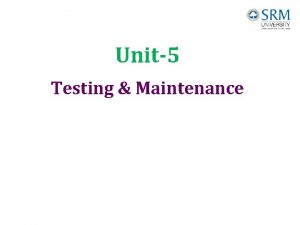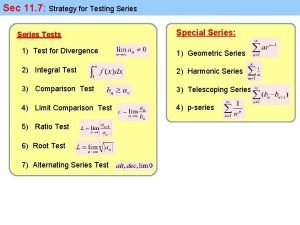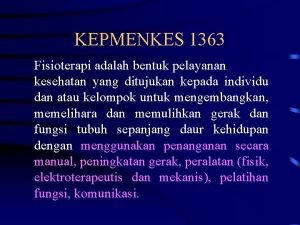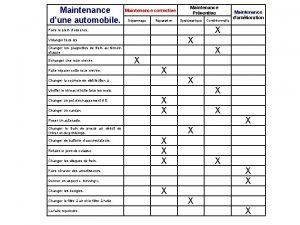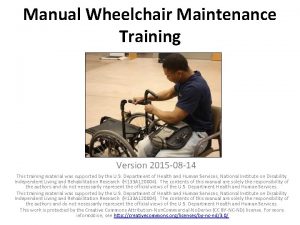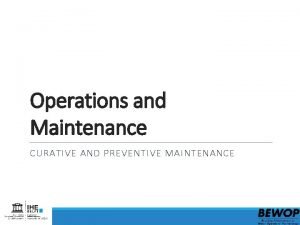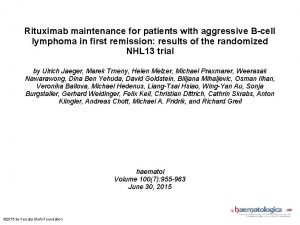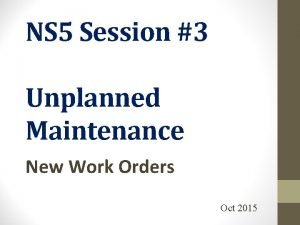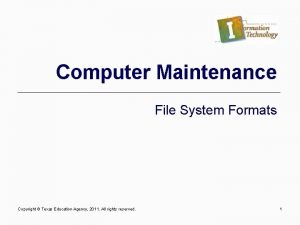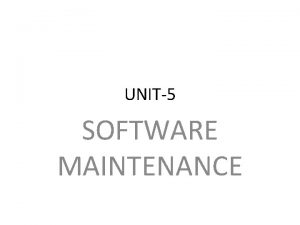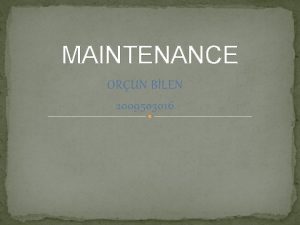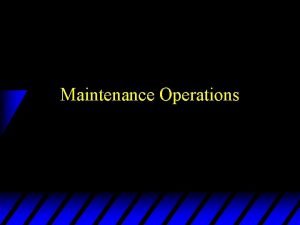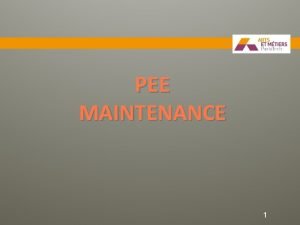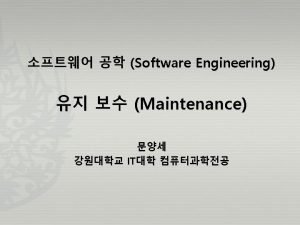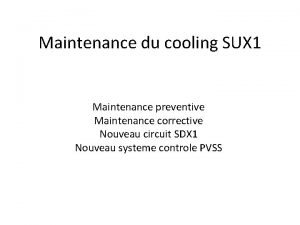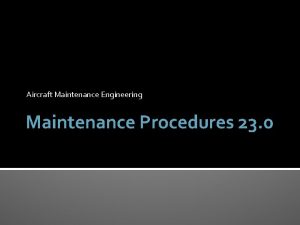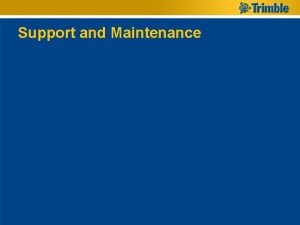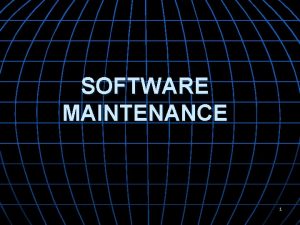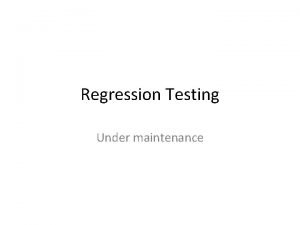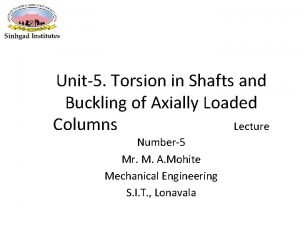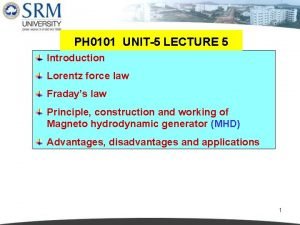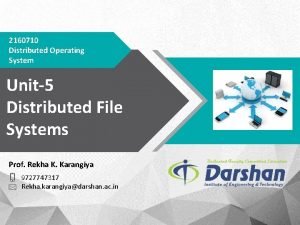Unit5 Testing Maintenance Testing strategies Testing is a









































- Slides: 41

Unit-5 Testing & Maintenance

Testing strategies Testing is a set of activities that can be planned in advance and conducted systematically. Generic characteristics • To perform effective testing, a software team should conduct effective formal technical reviews • Testing begins at the component level and work outward toward the integration of the entire computer-based system • Different testing techniques are appropriate at different points in time • Testing is conducted by the developer of the software and (for large projects) by an independent test group • Testing and debugging are different activities, but debugging must be accommodated in any testing strategy

Strategic Issues • Specify product requirements in a quantifiable manner long before testing commences • State testing objectives explicitly • Understand the users of the software and develop a profile for each user category • Develop a testing plan that emphasizes “rapid cycle testing” • Build “robust” software that is designed to test itself • Use effective technical reviews as a filter prior to testing • Conduct technical reviews to assess the test strategy and test cases themselves • Develop a continuous improvement approach for testing process

Testing strategies for Conventional Software Na Br rro oa w de to rs co p e System Testing Validation Testing Integration Testing Unit Testing Ab co str nc ac re t t te o Code Design Requirements System Engineering

Unit Testing • Unit testing focuses verification effort on the smallest unit of software design—the software component or module • The unit test focuses on the internal processing logic and data structures within the boundaries of a component

Unit testing considerations • The module interface is tested to ensure that information properly flows into and out of the program unit under test. • Local data structures are examined to ensure that data stored temporarily maintains its integrity during all steps in an algorithm’s execution. • All independent paths through the control structure are exercised to ensure that all statements in a module have been executed at least once. • Boundary conditions are tested to ensure that the module operates properly at boundaries established to limit or restrict processing. • Finally, all error-handling paths are tested. • Data flow across a component interface is tested before any other testing is initiated. If data do not enter and exit properly, all other tests are moot

Among the potential errors that should be tested when error handling is evaluated are (1) error description is unintelligible, (2) error noted does not correspond to error encountered, (3) error condition causes system intervention prior to error handling, (4) exception-condition processing is incorrect, or (5) Error description does not provide enough information to assist in the location of the cause of the error


• Driver – A simple main program that accepts test case data, passes such data to the component being tested, and prints the returned results • Stubs – Serve to replace modules that are subordinate to (called by) the component to be tested – It uses the module’s exact interface, may do minimal data manipulation, provides verification of entry, and returns control to the module undergoing testing • Drivers and stubs both represent overhead – Both must be written but don’t constitute part of the installed software product

Integration Testing • Integration testing is a systematic technique for constructing the software architecture while at the same time conducting tests to uncover errors associated with interfacing. • The objective is to take unit-tested components and build a program structure that has been dictated by design. • There is often a tendency to attempt non-incremental integration; that is, to construct the program using a “big bang” approach. • The entire program is tested as a whole. A set of errors is encountered. • Correction is difficult because isolation of causes is complicated by the vast expanse of the entire program. Once these errors are corrected, new ones appear and the process continues in a seemingly endless loop.

Incremental Integration Testing • Three kinds – Top-down integration – Bottom-up integration – Sandwich integration • The program is constructed and tested in small increments • Errors are easier to isolate and correct • Interfaces are more likely to be tested completely • A systematic test approach is applied

• Top-down integration testing is an incremental approach to construction of the software architecture. Modules are integrated by moving downward through the control hierarchy, beginning with the main control module

• depth-first integration integrates all components on a major control path of the program structure. • Selection of a major path is some what arbitrary and depends on application-specific characteristics. • For example, selecting the left-hand path, components M 1, M 2 , M 5 would be integrated first. Next, M 8 or (if necessary for proper functioning of M 2) M 6 would be integrated. • Then, the central and right-hand control paths are built. • Breadth-first integration incorporates all components directly subordinate at each level, moving across the structure horizontally. • From the figure, components M 2, M 3, and M 4 would be integrated first. The next control level, M 5, M 6, and so on, follows

The integration process is performed in a series of five steps: 1. The main control module is used as a test driver and stubs are substituted for all components directly subordinate to the main control module. 2. Depending on the integration approach selected (i. e. , depth or breadth first), subordinate stubs are replaced one at a time with actual components. 3. Tests are conducted as each component is integrated. 4. On completion of each set of tests, another stub is replaced with the real component. 5. Regression testing may be conducted to ensure that new errors have not been introduced. The process continues from step 2 until the entire program structure is built

As a tester, three choices: 1. delay many tests until stubs are replaced with actual modules, 2. develop stubs that perform limited functions that simulate the actual module, 3. integrate the software from the bottom of the hierarchy upward • The first approach (delay tests until stubs are replaced by actual modules) can cause you to lose some control over correspondence between specific tests and incorporation of specific modules. This can lead to difficulty in determining the cause of errors and tends to violate the highly constrained nature of the topdown approach. • The second approach is workable but can lead to significant overhead, as stubs become more and more complex. • The third approach, is called bottom-up integration

Bottom up Integration

• Bottom-up integration testing, begins construction and testing with atomic modules (i. e. , components at the lowest levels in the program structure). Because components are integrated from the bottom up, the functionality provided by components subordinate to a given level is always available and the need for stubs is eliminated. A bottom-up integration strategy may be implemented with the following steps: 1. Low-level components are combined into clusters (sometimes called builds) that perform a specific software sub function. 2. A driver (a control program for testing) is written to coordinate test case input and output. 3. The cluster is tested. 4. Drivers are removed and clusters are combined moving upward in the program structure

Top-down Integration • Modules are integrated by moving downward through the control hierarchy, beginning with the main module • Subordinate modules are incorporated in either a depth-first or breadthfirst fashion – DF: All modules on a major control path are integrated – BF: All modules directly subordinate at each level are integrated • Advantages – This approach verifies major control or decision points early in the test process • Disadvantages – Stubs need to be created to substitute for modules that have not been built or tested yet; this code is later discarded – Because stubs are used to replace lower level modules, no significant data flow can occur until much later in the integration/testing process

Bottom-up Integration • Integration and testing starts with the most atomic modules in the control hierarchy • Advantages – This approach verifies low-level data processing early in the testing process – Need for stubs is eliminated • Disadvantages – Driver modules need to be built to test the lower-level modules; this code is later discarded or expanded into a full-featured version – Drivers inherently do not contain the complete algorithms that will eventually use the services of the lower-level modules; consequently, testing may be incomplete or more testing may be needed later when the upper level modules are available

Sandwich Integration • Consists of a combination of both top-down and bottom-up integration • Occurs both at the highest level modules and also at the lowest level modules • Proceeds using functional groups of modules, with each group completed before the next – High and low-level modules are grouped based on the control and data processing they provide for a specific program feature – Integration within the group progresses in alternating steps between the high and low level modules of the group – When integration for a certain functional group is complete, integration and testing moves onto the next group • Reaps the advantages of both types of integration while minimizing the need for drivers and stubs • Requires a disciplined approach so that integration doesn’t tend towards the “big bang” scenario

Regression Testing • Each new addition or change to baselined software may cause problems with functions that previously worked flawlessly • Regression testing re-executes a small subset of tests that have already been conducted – Ensures that changes have not propagated unintended side effects – Helps to ensure that changes do not introduce unintended behavior or additional errors – May be done manually or through the use of automated capture/playback tools • Regression test suite contains three different classes of test cases – A representative sample of tests that will exercise all software functions – Additional tests that focus on software functions that are likely to be affected by the change – Tests that focus on the actual software components that have been changed

Smoke Testing • Taken from the world of hardware – Power is applied and a technician checks for sparks, smoke, or other dramatic signs of fundamental failure • Designed as a pacing mechanism for time-critical projects – Allows the software team to assess its project on a frequent basis • Includes the following activities – The software is compiled and linked into a build – A series of breadth tests is designed to expose errors that will keep the build from properly performing its function. The goal is to uncover “show stopper” errors that have the highest likelihood of throwing the software project behind schedule – The build is integrated with other builds and the entire product is smoke tested daily –After a smoke test is completed, detailed test scripts are executed

Benefits of Smoke Testing • Integration risk is minimized – Daily testing uncovers incompatibilities and show-stoppers early in the testing process, thereby reducing schedule impact • The quality of the end-product is improved – Smoke testing is likely to uncover both functional errors and architectural and component-level design errors • Error diagnosis and correction are simplified – Smoke testing will probably uncover errors in the newest components that were integrated • Progress is easier to assess – As integration testing progresses, more software has been integrated and more has been demonstrated to work

Test Strategies for Object-Oriented Software Unit Testing in OO Context • When object-oriented software is considered, the concept of the unit changes. • Encapsulation drives the definition of classes and objects. • An encapsulated class is usually the focus of unit testing. However, operations (methods) within the class are the smallest testable units. • Because a class can contain a number of different operations, and a particular operation may exist as part of a number of different classes, the tactics applied to unit testing must change.

• Class testing for OO software is the equivalent of unit testing for conventional software. • Unlike unit testing of conventional software, which tends to focus on the algorithmic detail of a module and the data that flow across the module interface, class testing for OO software is driven by the operations encapsulated by the class and the state behavior of the class

Integration Testing in OO Context • Two different object-oriented testing strategies – Thread-based testing • Integrates the set of classes required to respond to one input or event for the system • Each thread is integrated and tested individually • Regression testing is applied to ensure that no side effects occur – Use-based testing • First tests the independent classes that use very few, if any, server classes • Then the next layer of classes, called dependent classes, are integrated • This sequence of testing layer of dependent classes continues until the entire system is constructed

• With object-oriented software, one can no longer test a single operation in isolation (conventional thinking) • Traditional top-down or bottom-up integration testing has little meaning • Class testing for object-oriented software is the equivalent of unit testing for conventional software – Focuses on operations encapsulated by the class and the state behavior of the class • Drivers can be used – To test operations at the lowest level and for testing whole groups of classes – To replace the user interface so that tests of system functionality can be conducted prior to implementation of the actual interface • Stubs can be used – In situations in which collaboration between classes is required but one or more of the collaborating classes has not yet been fully implemented

Test Strategies For Webapps The strategy for Web. App testing adopts the basic principles for all software testing and applies a strategy and tactics that are used for object-oriented systems. The following steps summarize the approach: 1. The content model for the Web. App is reviewed to uncover errors. 2. The interface model is reviewed to ensure that all use cases can be accommodated. 3 The design model for the Web. App is reviewed to uncover navigation errors. 4. The user interface is tested to uncover errors in presentation and/or navigation mechanics. 5. Each functional component is unit tested. 6. Navigation throughout the architecture is tested. 7. The Web. App is implemented in a variety of different environmental configurations and is tested for compatibility with each configuration. 8. Security tests are conducted in an attempt to exploit vulnerabilities in the Web. App or within its environment. 9. Performance tests are conducted. 10. The Web. App is tested by a controlled and monitored population of end users. The results of their interaction with the system are evaluated for content and navigation errors, usability concerns, compatibility concerns, and Web. App reliability and performance. Because many Web. Apps evolve continuously, the testing process is an ongoing activity, conducted by support staff who use regression tests derived from the tests developed when the Web. App was first engineered. Methods for Web. App testing are considered •

Verification & Validation • Verification refers to the set of tasks that ensure that software correctly implements a specific function. • Validation refers to a different set of tasks that ensure that the software that has been built is traceable to customer requirements. • Verification: “Are we building the product right? ” • Validation: “Are we building the right product? ” The definition of V&V encompasses many software quality assurance activities

Validation Testing • Validation testing follows integration testing • The distinction between conventional and object-oriented software disappears • Focuses on user-visible actions and user-recognizable output from the system • Demonstrates conformity with requirements • Designed to ensure that – – – All functional requirements are satisfied All behavioral characteristics are achieved All performance requirements are attained Documentation is correct Usability and other requirements are met (e. g. , transportability, compatibility, error recovery, maintainability) • After each validation test – The function or performance characteristic conforms to specification and is accepted – A deviation from specification is uncovered and a deficiency list is created • A configuration review or audit ensures that all elements of the software configuration have been properly developed, cataloged, and have the necessary detail for entering the support phase of the software life cycle

• Alpha testing – Conducted at the developer’s site by end users – Software is used in a natural setting with developers watching intently – Testing is conducted in a controlled environment • Beta testing – Conducted at end-user sites – Developer is generally not present – It serves as a live application of the software in an environment that cannot be controlled by the developer – The end-user records all problems that are encountered and reports these to the developers at regular intervals • After beta testing is complete, software engineers make software modifications and prepare for release of the software product to the entire customer base

System Testing System testing is actually a series of different tests whose primary purpose is to fully exercise the computer-based system. • Recovery testing – Tests for recovery from system faults – Forces the software to fail in a variety of ways and verifies that recovery is properly performed – Tests reinitialization, checkpointing mechanisms, data recovery, and restart for correctness • Security testing – Verifies that protection mechanisms built into a system will, in fact, protect it from improper access

• Stress testing – Executes a system in a manner that demands resources in abnormal quantity, frequency, or volume • Performance testing – Tests the run-time performance of software within the context of an integrated system – Often coupled with stress testing and usually requires both hardware and software instrumentation – Can uncover situations that lead to degradation and possible system failure

• Deployment testing-(called configuration testing), – exercises the software in each environment in which it is to operate. • In addition, deployment testing examines all installation procedures and specialized installation software (e. g. , “installers”) that will be used by customers, and all documentation that will be used to introduce the software to end users.

The Art of Debugging • Debugging occurs as a consequence of successful testing • It is still very much an art rather than a science • Good debugging ability may be an innate human trait • Large variances in debugging ability exist • The debugging process begins with the execution of a test case • Results are assessed and the difference between expected and actual performance is encountered • This difference is a symptom of an underlying cause that lies hidden • The debugging process attempts to match symptom with cause, thereby leading to error correction

Why is Debugging so Difficult? • The symptom and the cause may be geographically remote • The symptom may disappear (temporarily) when another error is corrected • The symptom may actually be caused by non-errors (e. g. , round-off accuracies) • The symptom may be caused by human error that is not easily traced The symptom may be a result of timing problems, rather than processing problems • It may be difficult to accurately reproduce input conditions, such as asynchronous real-time information • The symptom may be intermittent such as in embedded systems involving both hardware and software • The symptom may be due to causes that are distributed across a number of tasks running on different processes

Debugging Strategies • Objective of debugging is to find and correct the cause of a software error • Bugs are found by a combination of systematic evaluation, intuition, and luck • Debugging methods and tools are not a substitute for careful evaluation based on a complete design model and clear source code • There are three main debugging strategies – Brute force – Backtracking – Cause elimination

Strategy #1: Brute Force • Most commonly used and least efficient method • Used when all else fails • Involves the use of memory dumps, run-time traces, and output statements • Leads many times to wasted effort and time

Strategy #2: Backtracking • Can be used successfully in small programs • The method starts at the location where a symptom has been uncovered • The source code is then traced backward (manually) until the location of the cause is found • In large programs, the number of potential backward paths may become unmanageably large

Strategy #3: Cause Elimination • Involves the use of induction or deduction and introduces the concept of binary partitioning – Induction (specific to general): Prove that a specific starting value is true; then prove the general case is true – Deduction (general to specific): Show that a specific conclusion follows from a set of general premises • Data related to the error occurrence are organized to isolate potential causes • A cause hypothesis is devised, and the aforementioned data are used to prove or disprove the hypothesis • Alternatively, a list of all possible causes is developed, and tests are conducted to eliminate each cause • If initial tests indicate that a particular cause hypothesis shows promise, data are refined in an attempt to isolate the bug

• Automated debugging Three Questions to ask Before Correcting the Error • Is the cause of the bug reproduced in another part of the program? – Similar errors may be occurring in other parts of the program • What next bug might be introduced by the fix that I’m about to make? – The source code (and even the design) should be studied to assess the coupling of logic and data structures related to the fix • What could we have done to prevent this bug in the first place? – This is the first step toward software quality assurance – By correcting the process as well as the product, the bug will be removed from the current program and may be eliminated from all future programs
 Data flow testing strategies in software testing
Data flow testing strategies in software testing Maintenance testing is
Maintenance testing is Object oriented testing strategies
Object oriented testing strategies Language
Language Strategy for testing series
Strategy for testing series Control structure testing in software testing
Control structure testing in software testing Domain testing
Domain testing Decision tables testing
Decision tables testing Globalization testing in software testing
Globalization testing in software testing Types of domain testing
Types of domain testing Decision table testing in software testing
Decision table testing in software testing Logic based testing
Logic based testing Rigorous testing in software testing
Rigorous testing in software testing Functional testing vs unit testing
Functional testing vs unit testing Jelaskan pengertian pengujian black box
Jelaskan pengertian pengujian black box Decision table advantages and disadvantages
Decision table advantages and disadvantages Positive testing vs negative testing
Positive testing vs negative testing Testing blindness in software testing
Testing blindness in software testing What is testing
What is testing Behavioral testing adalah
Behavioral testing adalah Cs3250
Cs3250 Component testing is a black box testing
Component testing is a black box testing Management de la maintenance
Management de la maintenance 5988 example
5988 example Maintenance decision support system
Maintenance decision support system Maintenance fisio adalah
Maintenance fisio adalah Contemplative vs precontemplation
Contemplative vs precontemplation English 2
English 2 Abaque de noiret
Abaque de noiret Socioemotional maintenance definition sociology
Socioemotional maintenance definition sociology Edge localized mode
Edge localized mode In this unit you learned to talk about home maintenance
In this unit you learned to talk about home maintenance Manual wheelchair maintenance checklist
Manual wheelchair maintenance checklist Curative maintenance
Curative maintenance Maintenance rituximab mantle cell lymphoma
Maintenance rituximab mantle cell lymphoma Day to day maintenance
Day to day maintenance Warehouse maintenance plan
Warehouse maintenance plan Lemg aircraft maintenance
Lemg aircraft maintenance Ns5 maintenance system
Ns5 maintenance system File system maintenance
File system maintenance Eddb aircraft maintenance
Eddb aircraft maintenance Flightlevel aviation aircraft maintenance
Flightlevel aviation aircraft maintenance

